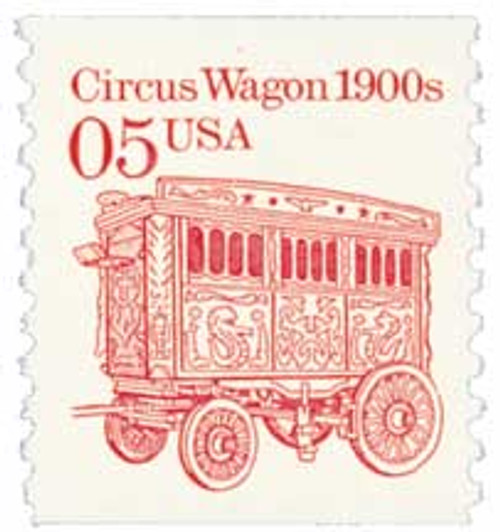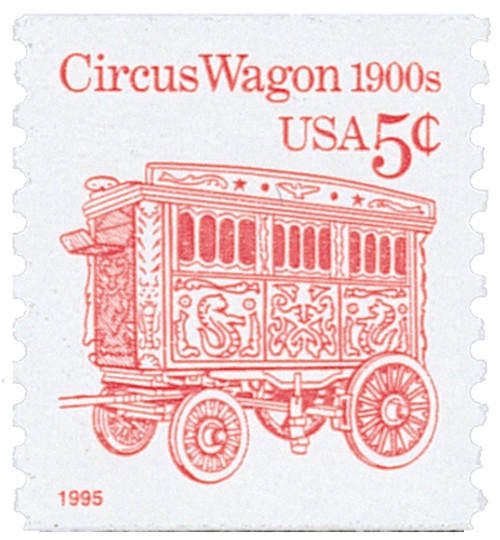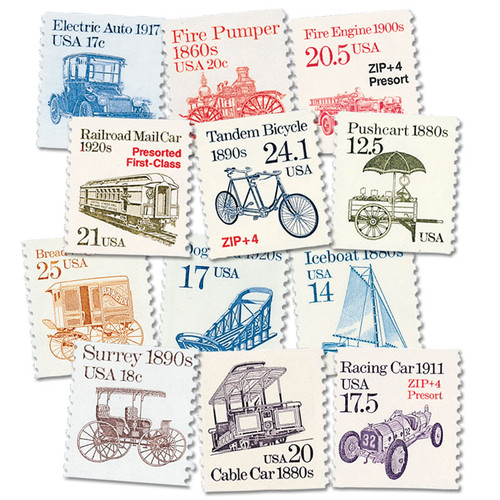
# 2468 - 1990-94 $1 Transportation Series: Seaplane, 1914
US #2468
1990 Seaplane
- First stamp in Transportation Series to feature aircraft
- First in series to picture humans
- Denomination was much higher than all previous Transportation stamps
Stamp Category: Definitive
Set : Transportation Series
Value: $1
First Day of Issue: April 20, 1990
First Day City: Phoenix, Arizona
Quantity Issued: 23,900,000
Printed by: Bureau of Engraving and Printing
Printing Method: Intaglio
Format: Coils of 500
Perforations: 9.8 vertically
Why the stamp was issued: The Seaplane stamp was intended for use in vending machines inside USPS post offices. Customers purchased the stamps when the post office was closed for use on parcels or heavier letters.
About the stamp design: Chuck Hodgson was the artist behind the stamp. His drawing was based on an advertising flyer for the St. Petersburg-Tamp Airboat Line. Hodgson reversed the original image to show the Benoist Airboat climbing into the sky.
Special design details: With the addition of the red “$1 USA”, this was the first stamp in the Transportation series to have two colors.
First Day City: The First Day of Issue ceremony was during the Aripex 90 show of the Arizona Federation of Stamp Clubs, held in Phoenix, Arizona. Originally, the 5¢ Circus Wagon was slated to be revealed at this time, but there was a need for $1 coil stamps, so the Seaplane stamp was issued ahead of the Circus Wagon stamp.
Unusual facts about this stamp: The $1 denomination was four times higher than any previous Transportation Series stamps.
This was the first stamp in the series to picture an aircraft and the first to include humans (the pilot and copilot).
About the Transportation Series: A ground-breaking stamp was quietly issued on May 18, 1981. For the first time in U.S. history, a coil stamp featured its own unique design rather than simply copying that of the current definitive stamp. Fifty more coil stamps would be issued over the course of the next 15 years, each picturing a different mode of transportation.
The various denominations provided face values to exactly match the rates for several categories of Third Class mail (bulk rate and quantity-discounted mail). As the rates changed, new stamps with new values were added. Never before had a stamp series included so many fractional cent values.
Most of the stamps in the Transportation Series were printed by the Bureau of Engraving and Printing, although a few were printed by private contractors. All but a few of the later stamps were produced by engraved intaglio. Differences in precancels, tagging, paper and gum provide a large number of varieties.
By the time the last stamp was issued in 1995, the Transportation Series had become the largest US coil stamp series in history.
History the stamp represents: This stamp features a 1914 seaplane. The first successful flight of this type of aircraft took place on March 28, 1910. Henri Fabre made the initial flight and traveled over 1,900 feet. This inaugurated the seaplane and the flying boat industry.
It took Fabre four years to develop his plane, which resembled a large wooden dragonfly flying backwards. Three hollow floats made it possible to take off and land on the water. He named his hydravion (the word at the time he used for the type of seaplane) Canard (duck) because its wings were similar to a duck with a small forewing ahead of the main wing. His plane was 45 feet wide, 27 feet long and weighed 837 pounds. It had a 50-horsepower engine and three floats.
Fabre, who had never flown before, staged his first flight on March 28, 1910, at Étang de Berre, Martigues, Bouches-du-Rhône, France. A large crowd assembled to watch the historic event. They witnessed him take off and land safely on the water four times, with his longest flight covering over 1,900 feet. Within a week, Canard made a three-and-a-half-mile trip. Inventors from other countries soon contacted Fabre to use his floats on their seaplanes.
The seaplane industry quickly grew, with the first hydro-aeroplane competition held in Monaco in 1912. Planes at that competition used floats from Fabre, Curtiss, Tellier, and Farman. France introduced the first scheduled seaplane passenger flights in 1912. That same year, Glenn L. Martin set time and distance records flying his own homemade seaplane in California.
American aviator Glenn Curtiss developed his Curtiss Model D between 1910 and 1911. It won him the first Collier Trophy for flight achievement in America. It paved the way for his Model E and Model F “flying boats.” One of his flying boats later became the first seaplane to cross the Atlantic Ocean.
In 1935, the Glenn L. Martin Company built three Martin M-130 Flying Boats. With a range of 3,200 miles, these seaplanes could fly mail and passengers over the Pacific. They were designed for Pan American Airways and were named the China Clipper, Philippine Clipper, and Hawaii Clipper.
During World War II, flying boats were in high demand for the military. They could conduct anti-submarine patrols, air-sea rescues, and gunfire spotting for battleships. The PBY Catalina was a leading US craft that rescued downed airmen and scouted enemy ships. Demand for flying boats declined dramatically after the war, as the length and number of runways had vastly increased. Flying boats were used during the Berlin Airlift, and the US Navy continued to use them until the 1970s. In 1990, the first round-the-world flight in a floatplane was completed.
US #2468
1990 Seaplane
- First stamp in Transportation Series to feature aircraft
- First in series to picture humans
- Denomination was much higher than all previous Transportation stamps
Stamp Category: Definitive
Set : Transportation Series
Value: $1
First Day of Issue: April 20, 1990
First Day City: Phoenix, Arizona
Quantity Issued: 23,900,000
Printed by: Bureau of Engraving and Printing
Printing Method: Intaglio
Format: Coils of 500
Perforations: 9.8 vertically
Why the stamp was issued: The Seaplane stamp was intended for use in vending machines inside USPS post offices. Customers purchased the stamps when the post office was closed for use on parcels or heavier letters.
About the stamp design: Chuck Hodgson was the artist behind the stamp. His drawing was based on an advertising flyer for the St. Petersburg-Tamp Airboat Line. Hodgson reversed the original image to show the Benoist Airboat climbing into the sky.
Special design details: With the addition of the red “$1 USA”, this was the first stamp in the Transportation series to have two colors.
First Day City: The First Day of Issue ceremony was during the Aripex 90 show of the Arizona Federation of Stamp Clubs, held in Phoenix, Arizona. Originally, the 5¢ Circus Wagon was slated to be revealed at this time, but there was a need for $1 coil stamps, so the Seaplane stamp was issued ahead of the Circus Wagon stamp.
Unusual facts about this stamp: The $1 denomination was four times higher than any previous Transportation Series stamps.
This was the first stamp in the series to picture an aircraft and the first to include humans (the pilot and copilot).
About the Transportation Series: A ground-breaking stamp was quietly issued on May 18, 1981. For the first time in U.S. history, a coil stamp featured its own unique design rather than simply copying that of the current definitive stamp. Fifty more coil stamps would be issued over the course of the next 15 years, each picturing a different mode of transportation.
The various denominations provided face values to exactly match the rates for several categories of Third Class mail (bulk rate and quantity-discounted mail). As the rates changed, new stamps with new values were added. Never before had a stamp series included so many fractional cent values.
Most of the stamps in the Transportation Series were printed by the Bureau of Engraving and Printing, although a few were printed by private contractors. All but a few of the later stamps were produced by engraved intaglio. Differences in precancels, tagging, paper and gum provide a large number of varieties.
By the time the last stamp was issued in 1995, the Transportation Series had become the largest US coil stamp series in history.
History the stamp represents: This stamp features a 1914 seaplane. The first successful flight of this type of aircraft took place on March 28, 1910. Henri Fabre made the initial flight and traveled over 1,900 feet. This inaugurated the seaplane and the flying boat industry.
It took Fabre four years to develop his plane, which resembled a large wooden dragonfly flying backwards. Three hollow floats made it possible to take off and land on the water. He named his hydravion (the word at the time he used for the type of seaplane) Canard (duck) because its wings were similar to a duck with a small forewing ahead of the main wing. His plane was 45 feet wide, 27 feet long and weighed 837 pounds. It had a 50-horsepower engine and three floats.
Fabre, who had never flown before, staged his first flight on March 28, 1910, at Étang de Berre, Martigues, Bouches-du-Rhône, France. A large crowd assembled to watch the historic event. They witnessed him take off and land safely on the water four times, with his longest flight covering over 1,900 feet. Within a week, Canard made a three-and-a-half-mile trip. Inventors from other countries soon contacted Fabre to use his floats on their seaplanes.
The seaplane industry quickly grew, with the first hydro-aeroplane competition held in Monaco in 1912. Planes at that competition used floats from Fabre, Curtiss, Tellier, and Farman. France introduced the first scheduled seaplane passenger flights in 1912. That same year, Glenn L. Martin set time and distance records flying his own homemade seaplane in California.
American aviator Glenn Curtiss developed his Curtiss Model D between 1910 and 1911. It won him the first Collier Trophy for flight achievement in America. It paved the way for his Model E and Model F “flying boats.” One of his flying boats later became the first seaplane to cross the Atlantic Ocean.
In 1935, the Glenn L. Martin Company built three Martin M-130 Flying Boats. With a range of 3,200 miles, these seaplanes could fly mail and passengers over the Pacific. They were designed for Pan American Airways and were named the China Clipper, Philippine Clipper, and Hawaii Clipper.
During World War II, flying boats were in high demand for the military. They could conduct anti-submarine patrols, air-sea rescues, and gunfire spotting for battleships. The PBY Catalina was a leading US craft that rescued downed airmen and scouted enemy ships. Demand for flying boats declined dramatically after the war, as the length and number of runways had vastly increased. Flying boats were used during the Berlin Airlift, and the US Navy continued to use them until the 1970s. In 1990, the first round-the-world flight in a floatplane was completed.





















